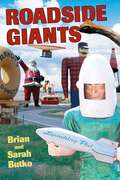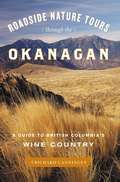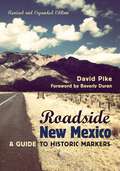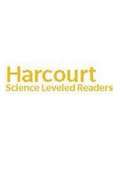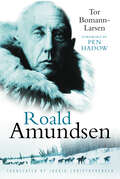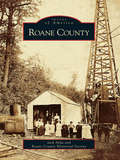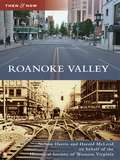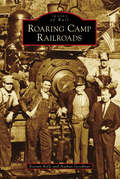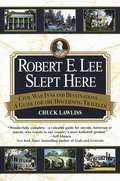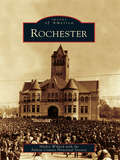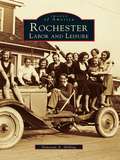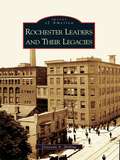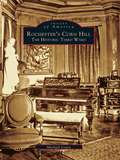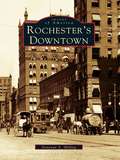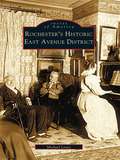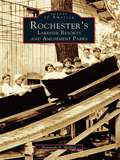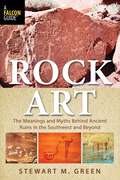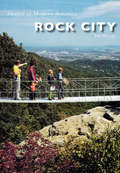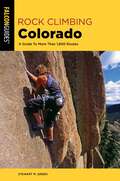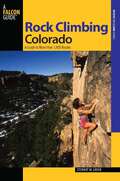- Table View
- List View
Roadside Giants
by Brian Butko Sarah ButkoFrom Lucy, the colossal elephant-shaped building on the Jersey Shore, to the grand donut atop Randy's in Los Angeles, this full-color guide profiles the commercial giants that loom over America's highways. Created to sell products and promote tourism in a big way, they can be found all over the United States. The authors have traveled far and wide to bring readers the world's largest duck in Long Island, an enormous Amish couple in Pennsylvania Dutch Country, and towering Paul Bunyans all over the Midwest. There are buildings shaped like hot dogs, ice cream cones, and baskets, as well as the roadside phenomena known as "Muffler Men," giants who originally advertised mufflers but now have been converted to cowboys, Indians, spacemen, and pirates. Big fun!
Roadside History of South Dakota
by Linda M. HasselstromDividing the state into four distinctive geographical regions-- Eastern South Dakota; the Missouri River and Great Lakes; Western South Dakota; and the Black Hills and Badlands--this book follows highway routes, engagingly recounting the history of the Indians (primarily Lakota) and the early white settlers, geographical features, past and present South Dakotan life and culture, and innumerable other fascinating aspects of the state. Includes numerous maps, illustrations, and historical photographs. Annotation c. by Book News, Inc. , Portland, Or.
Roadside Nature Tours through the Okanagan
by Richard CanningsThe Okanagan attracts thousands of visitors each year to enjoy its beaches and wine, but more and more people are discovering its natural beauty. With desert sands and deep lakes, towering rock cliffs and rich benchlands, cold mountain forests and hot grasslands, the Okanagan has an ecological diversity unequalled in Canada.Roadside Nature Tours through the Okanagan opens with an introduction to the region's biodiversity, climate, geology, and human history, setting the stage for the route descriptions that follow. Richard Cannings then takes us on twenty-one tours through the valley, from the arid benchlands of Osoyoos to the snowy forests east of Vernon. The routes vary from main highways to quiet roads, and along each one we're introduced to the animals, plants, and bedrock that create this national treasure. Each route also has a focal topic, ranging from owls to salmon and rattlesnakes to rock rabbits.
Roadside New Mexico: A Guide to Historic Markers, Revised and Expanded Edition
by David PikeThrough New Mexico&’s Official Scenic Historic Markers we learn about the people, the geological features, and the historical events that have made the Land of Enchantment a place unlike any other. An index to our history, these markers tell an incredible story about our cultures and origins. This revised and expanded edition of Roadside New Mexico provides additional information about these sites and includes approximately one hundred new markers, sixty-five of which document the contribution of women to the history of New Mexico.Now structured alphabetically for easier identification, each essay also offers suggestions of similar Historic Markers to help readers explore each topic further. In addition, Pike includes entries on &“Ghost Markers&”—those sites missing from the road that still impart significant historical lessons. Roadside New Mexico delivers a useful companion for travelers who want to understand more about the landscapes and inhabitants of the state.
Roadtrip USA
by The Editors at the Harcourt School PublishersThe book is all about roadside America, road trips and attractions in various regions of America.
Roald Amundsen
by Tor Bomann-Larsen Pen Hadow Ingrid ChristophersonOn 14 December 1911, the Norwegian explorer Roald Amundsen and his team became the first human beings to reach the South Pole, just over a month before Robert Falcon Scott's ill-fated Terra Nova expedition. He had already led the first expedition to traverse the North West Passage, and would go on to lead the first successful attempt to cross the Arctic by air (perhaps even becoming the first to reach the North Pole, according to some interpretations). Yet his personal life was messy to say the least, with a string of mistresses, including Eskimo girls he brought back to Norway, and a poisonous relationship with his brother. He disappeared in 1928 while taking part in an airborne rescue mission in the Arctic; his body was never found. Tor Bomann-Larsen's account of his life is the only full biography of Amundsen to be published in English.
Roane County
by Jack Nida Roane County Historical SocietyEstablished in March 1856, Roane County was named forVirginia jurist Spencer Roane. The town of New California was selected as the county seat, and in 1858, the name was changed to Spencer to further honor the judge. The courthouse built in 1859 was destroyed by fire in 1887. A new county courthouse was completed in 1889, and the railroad arrivedin Spencer in 1892. New businesses and industry flourished as Spencer became the county hub. Summer normal schools were established throughout the county to prepare young teachers for state certification. In 1914, Spencer High School graduatedone pupil in its first class. The early recognition for education expanded with the construction of one- and two-room schools within each community. Timbering began as people moved westward and established new homes and farming lands. The development of the gas and oil industry soon followed, and Roane County became a major producer by the early 1900s.
Roanoke Valley
by Nelson Harris Harold Mcleod Historical Society of Western VirginiaNestled in the shadows of the Blue Ridge, the Roanoke Valley has developed as the capital region for western Virginia. After a century of growth fueled by transportation, education, and healthcare, the region has undergone significant visible change. While some of the valley's landmarks remain, many have been replaced or dramatically altered.
Roaring Camp Railroads
by Nathan Goodman Beniam KifleIn 1963, Norman Clark officially opened Roaring Camp to the public. Since then, it has become a popular and well-known destination, in the Santa Cruz mountains south of San Francisco, for tourists and rail buffs from around the world who wish to visit and ride on its 100-year-old steam trains. <P><P> Isaac Graham, who constructed the first powered sawmill and the first whiskey distillery in the American West, settled the area in the 1840s. Graham was notorious for his boisterous antics, and his settlement became known as a "wild and roaring camp." Clark arrived in the area in the mid-1950s with $25 in his pocket and the dream of preserving a piece of early California. Clark's dream included a plan to construct an 1880s railroad town, complete with an authentic narrow-gauge logging railway. Over the last 50 years, Clark's dream has been continued and expanded, now incorporating two railroads, one of which dates to 1875.
Roaring Camp: The Social World of the California Gold Rush
by Susan E. JohnsonIn this thoroughly researched volume, drawing upon a wealth of primary sources, Johnson examines the world of the California Gold Rush with emphasis on race, ethnicity, and gender issues. She contrasts the conventional images of Gold Rush participants - Anglo males from the eastern U.S. heading west to sek their fortunes - with the reality. In fact, the Gold Rush brought together people from highly diverse backgrounds and forced them to interact with one another. Native Americans, Latinos from several nations, Anglos from the eastern U.S., European immigrants, and African Americans (both free and enslaved) all played key roles. Women of all backgrounds were also present in small but significant numbers, finding opportunities to work and live with unprecedented independence. Initially Gold Rush society was outside the bounds of accepted U.S. mores, forcing participants to relate to one another in new ways. As more Anglo women moved to California to join male relatives, middle-class standards were brought to bear on the "lawless" Gold Rush country.
Robert Ballard: Deepwater Explorer
by Jeffrey B. Fuerst Racheal RiceHow can you get eyes on the ocean floor at depths that would crush a human? Robert Ballard discovered how: using remotely operated vehicles equipped with cameras. Ballard combed the ocean floor looking for the Titanic, which tragically sank in 1912 on its very first voyage. His quest to find the grandest ship ever built led to technology that gave us the chance to discover more about Earth's oceans than ever before.
Robert E. Lee Slept Here
by Chuck LawlissImagine sleeping in General Sherman's Savannah headquarters . . . sharing a night's rest with the friendly ghost of a Union soldier who plays the violin. . . staying in a Georgia inn where Confederate gold may be buried . . . or crashing at a Carolina hostelry with its very own battlefield. For those fascinated by the Civil War, this engaging travel book offers a unique look into the best landmarks to visit and most interesting places to stay--more than a hundred intimate and historically authentic inns and bed-and-breakfasts, whose very owners are often descended from Civil War veterans.Inside you will find addresses, contact numbers, and detailed descriptions of the ambiance and amenities of each lodging, including rates and discounts. The author also provides information, both historical and practical, on museums, battlefields, reenactments, parks, and other interesting sites--from infamous Pea Patch Island Prison in Delaware to the grandest of all antebellum mansions, Louisiana's sixty-six-room Nottoway Plantation, now an inn ready to wrap you in luxury.With the help of this very special guidebook, you will be transported back to a bygone era and fully experience one of the turning points of American history.From the Trade Paperback edition.
Robert T. Moran's Cultural Guide to Doing Business in Europe
by Michael Johnson Robert T. MoranThe author tells how he would do business in Europe. He reviews the cultures of different countries.
Rochelle
by Carol HegbergThe Lincoln Highway through Rochelle was originally a Potawatomi Indian trail. In 1853, Robert P. Lane purchased land from Charlotte Bartholomew, Sheldon Bartholomew's widow, near the settlement known as Hickory Grove, and the community became officially known as Lane. After a hanging scandal, the citizens renamed their village Rochelle. From then, the town grew to the largest city in Ogle County. Rochelle's famous railroad park and the diamond (crossing of the Burlington Northern and Santa Fe Railroad and the Union Pacific Railroad) attract visitors throughout the year. The park's tourist center is located in a refurbished Standard Oil gas station. The Flagg Township Historical Museum offers times gone by in many forms in the 1884 city hall, which is on the National Register of Historic Places. Rochelle offers suburban amenities with the healthy atmosphere of the small town where actress Joan Allen grew up.
Rochester
by Shirley Willard Fulton County Historical SocietyThe county seat of Fulton County, Rochester is a small rural town in north-central Indiana. Its history includes many famous people. Despite the mistaken trivia game answer, Elmo Lincoln, the first Tarzan in 1918, was born in Rochester, Indiana, not New York. And John Chamberlain, famous modern sculptor, was born here too. Clyde Beatty, wild animal trainer extraordinaire, lived here while the Cole Brothers-Clyde Beatty Circus had its winter quarters in Rochester in the 1930s. For a community with such a small population, Rochester has harbored more than its share of famous people.
Rochester Labor and Leisure: Labor And Leisure (Images of America)
by Donovan A. ShillingRochester: Labor and Leisure is a visual celebration of the industrial strengths and the commercial successes of an earlier time. Located on the Genesee River, the city used the waterway to full advantage. Industries lined the riverbank, and the town thrived with enterprise and initiative. Rochester's vibrant and productive residents knew not only how to work hard but also how to enjoy life. With more than two hundred stunning photographs, Rochester: Labor and Leisure highlights the progress of the city's entrepreneurs, such as tobacco king William Kimball, oil tycoon Hiram Bond Everest, and museum operator Rattlesnake Pete. It reveals nightlife in the Gay Nineties and Front Street as it once was. It echoes the city's unforgettable one-hundredth birthday party and the acclaim received for building an aqueduct.
Rochester Leaders and Their Legacies (Images of America)
by Donovan A. ShillingRochester owes much to those who made it the exceptional andunique city it has become. Many of the civic, commercial, industrial, and entertainment leaders who brought fame and prosperity to the city are saluted in Rochester Leaders and Their Legacies. A gallery of rare photographs reveals the images of the founders and their legacies: McCurdy's, McFarlin's, Edwards, and Sibley's department stores; important businesses and products; and entertainment venues and memories. Here are glimpses of the nursery industry, Erie Canal, trolley days, downtown nightspots, theater performers, and recollections of unusual events, from fires and floods to the huge Elks Street Fair of 1899.
Rochester's Corn Hill: The Historic Third Ward (Images of America)
by Michael LeavyWhen Rochester experienced the explosive growth generated by the Erie Canal, what began as a pioneer neighborhood of cabins quickly became an impressive ward of mansions for the city's social hierarchy. Today's generation knows it as Corn Hill, but it is actually the old Third Ward, an extraordinary neighborhood that rivaled Charleston, Savannah, and Natchez in elegance and importance. Rochester's Corn Hill: The Historic Third Ward offers the first comprehensive pictorial history of this ruffled-shirt district from its humble beginnings, to its Victorian peak, through its eventual decline and subsequent rehabilitation into a landmark ward.
Rochester's Downtown
by Donovan A. ShillingDowntown Rochester is defined by Main Street, State Street, and the major crossroads of those streets. It is the core of one of New York State's most important cities. Rochester's Downtown recaptures the golden era when downtown bloomed as a mecca for daytime workers and shoppers and for an evening's entertainment at vibrant social centers. Rochester's Downtown celebrates the people of this great city as they progress from their early beginnings to create a dynamic business center. This excellent collection of images regenerates the excitement of riding the trolley, of watching a movie at the Palace or the Capitol, of window-shopping at the Duffy-Powers Store, and of tasting frosted malteds at Sibley's or warm doughnuts from the Mayflower Donut Shop or spoonfuls of roasted peanuts from Mr. Peanut Man. The narrative recalls Scrantom's as the place to buy books, Neisner's having the latest 78-rpm records, McCurdy's and Edward's with their special holiday displays, Eddie's Chop House for memorable dinners, and the Century Sweet Shop for after-theater sundaes.
Rochester's Historic East Avenue District
by Michael LeavyAmerican cities and towns have always prided themselves on their grand avenues. The social elite and industrial captains often transformed normal thoroughfares into magnificent promenades lined with mansions to showcase their wealth. Post-Civil War America experienced a burst of this activity, but Rochester, America's first true boomtown, had already set its sights on a grand avenue as early as 1840. The nouveau riche were anxious to establish a prestigious social colony befitting their stature. Using local and national architects, landscapers, and craftsmen, they transformed East Avenue from a crudely hacked pioneer lane into one of the grandest approaches to any city in the world. Although somewhat altered, it is still Rochester's most beautiful street and remains one of Monroe County's most spectacular features.
Rochester's Lakeside Resorts and Amusement Parks
by Donovan A. ShillingThe period from 1884 to 1926 was the heyday of thetrolley lines, the height of steam travel, and the peak of interest in the "back to nature" movement. It was a time for spiritual renewal, when society was encouraged to enjoy family activities in the fresh air. Resorts served as an escape from summer's oppressive heat and offered a world of fun, fantasy, and fishing--a world far removed from the toils of the shop, the chores of the farm, or the everyday drudgery demanded by a labor intensive, pre-electric society. Rochester's Lakeside Resorts and Amusement Parks documents in over 200 photographs the development, dates, locations, and attractions that were a unique part of the rich history of each resort. Offering a window into yesterday, this book reveals many unusual facts about the area and features the fascinating characters who owned and operated the impressive hotels, boats, trolley lines, and amusement concessions.
Rock Art: The Meanings and Myths Behind Ancient Ruins in the Southwest and Beyond
by Stewart M. GreenThe Definitive Guide to Ancient and Contemporary Rock Art!Rock Art explores the fascinating history of ancient human-made stone markings that have puzzled historians, archaeologists, and hikers alike for centuries. What is rock art, and who created these mysterious symbols, and why are so many pieces of artwork similar across disparate and long-forgotten cultures? How was rock art made—and, more importantly, why? These questions and more are addressed in this comprehensive guide, complete with full-color images and travel listings. Look inside to find:Prehistories and histories of the cultures who created these images and etchings.Detailed descriptions of the tools, techniques, and methods used to create rock art.Best practices and techniques for photographing these alluring rock images.Extensive list of rock art sites across the United States.Whether you&’re fascinated by the wondrous ancient imagery imprinted on the landscape or just curious about the markings alongside your favorite hiking trail, Rock Art is the only guide you need to better understand this mysterious and beautiful art form.
Rock City: The History Of Rock City Gardens (Images of Modern America)
by Tim HollisSince May 21, 1932, tourists have been making the trip to the top of Lookout Mountain to stroll through what pioneers as far back as the 1820s called “the rock city.” This collection of huge boulders in a wild array of shapes and sizes was developed as an attraction by Garnet Carter, the inventor of modern miniature golf, and his wife, Frieda, a devotee of European fairy tales. Rock City Gardens quickly became one of the most famous tourist attractions in the Southeast, especially after Carter started a program of painting advertisements on barn roofs. During the post–World War II baby-boom era, Rock City became even more of a destination with the additions of Fairyland Caverns and Mother Goose Village.
Rock Climbing Colorado: A Guide To More Than 1,800 Routes (State Rock Climbing Series)
by Stewart M. GreenThe birthplace of American rock climbing, Colorado provides a greater variety of rock and routes than any other state—and Rock Climbing Colorado is the only guidebook available to all its major climbing areas. This updated edition includes hundreds of routes. Included are the big cliffs and faces of Rocky Mountain National Park and the Black Canyon of the Gunnison, as well as the smaller crags and outcrops of Pikes Peak, Boulder, Rifle, Shelf Road, Elevenmile Canyon, and many more. All areas covered include first-hand overviews, route descriptions, topos, and full-color photos. Rock Climbing Colorado is ideal for anyone aiming to discover, or rediscover, the diverse and wonderful rock climbing found in the Centennial State.
Rock Climbing Colorado: A Guide to More Than 1,800 Routes (State Rock Climbing Series)
by Stewart M. GreenThis book is the only guide available that covers all the major climbing areas in the state with routes ranging from 5.0 to 5.14.
